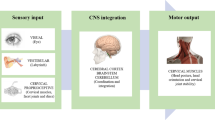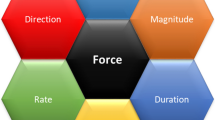Abstract
The shoulder joint has a high degree of freedom and an extremely complex and unstable kinematic mechanism. Coordinated contraction of the rotator cuff muscles that stop around the humeral head and the deltoid muscles and the extensibility of soft tissues, such as the joint capsule, labrum, and ligaments, contribute to shoulder-joint stability. Understanding the mechanics of shoulder-joint movement, including soft-tissue characteristics, is important for disease prevention and the development of a device for disease treatment. This study aimed to create a musculoskeletal shoulder model to represent the realistic behavior of joint movement and soft-tissue deformation as a dynamic simulation using a rigid-body model for bones and a soft-body model for soft tissues via a spring–damper–mass system. To reproduce the muscle-contraction properties of organisms, we used a muscle-expansion representation and Hill’s mechanical muscle model. Shoulder motion, including the movement of the center of rotation in joints, was reproduced, and the strain in the joint capsule during dynamic shoulder movement was quantified. Furthermore, we investigated narrowing of the acromiohumeral distance in several situations to induce tissue damage due to rotator cuff impingement at the anterior–subacromial border during shoulder abduction. Given that the model can analyze exercises under disease conditions, such as muscle and tendon injuries and impingement syndrome, the proposed model is expected to help elucidate disease mechanisms and develop treatment guidelines.









Similar content being viewed by others
References
Akkaya N, Akkaya S, Gungor HR, Yaşar G, Atalay NS, Sahin F (2017) Effects of weighted and un-weighted pendulum exercises on ultrasonographic acromiohumeral distance in patients with subacromial impingement syndrome. J Back Musculoskelet Rehabil 30:221–228
Aurbach M, Spicka J, Süß F, Dendorfer S (2020) Evaluation of musculoskeletal modelling parameters of the shoulder complex during humeral abduction above 90°. J Biomech 106:109817
BodyParts3D/Anatomography (2008) Database Center for Life Science. http://lifesciencedb.jp/bp3d/.
Buchanan TS, Lloyd DG, Manal K, Besier TF (2004) Neuromusculoskeletal modeling: estimation of muscle forces and joint moments and movements from measurements of neural command. J Appl Biomech 20:367–395
Bullet BP (2015). Library. http://bulletphysics.org (Accessed 21/3/2022).
Chadwick EK, Blana D, Kirsch RF, van den Bogert AJ (2014) Real-time simulation of three-dimensional shoulder girdle and arm dynamics. IEEE Trans Bio Med Eng 61:1947–1956
Chopp JN, Dickerson CR (2012) Resolving the contributions of fatigue-induced migration and scapular reorientation on the subacromial space: an orthopaedic geometric simulation analysis. Hum Mov Sci 31:448–460
Debski RE, Sakone M, Woo SL, Wong EK, Fu FH, Warner JJ (1999) Contribution of the passive properties of the rotator cuff to glenohumeral stability during anterior-posterior loading. J Shoulder Elbow Surg 8:324–329
Enoka RM (2015) Neuromechanics of human movement, 5th edn. Human Kinetics.
Flores-Hernandez C, Eskinazi I, Hoenecke HR, D’Lima DD (2019) Scapulothoracic rhythm affects glenohumeral joint force. JSES Open Access 3:77–82
Garving C, Jakob S, Bauer I, Nadjar R, Brunner UH (2017) Impingement syndrome of the shoulder. Dtsch Arztebl Int 114:765–776
Giphart JE, van der Meijden OAJ, Millett PJ (2012) The effects of arm elevation on the 3-dimensional acromiohumeral distance: a biplane fluoroscopy study with normative data. J Shoulder Elbow Surg 21:1593–1600
Gordon AM, Huxley AF, Julian FJ (1966) The variation in isometric tension with sarcomere length in vertebrate muscle fibres. J Physiol 184:170–192
Halder AM, Zhao KD, Odriscoll SW, Morrey BF, An KN (2001) Dynamic contributions to superior shoulder stability. J Orthop Res 19:206–212
Harrison AK, Flatow EL (2011) Subacromial impingement syndrome. J Am Acad Orthop Surg 19:701–708
Hill AV (1938) The heat of shortening and the dynamic constants of muscle. Proc R Soc Lond A 126:136–195
Holzbaur KRS, Murray WM, Delp SL (2005) A model of the upper extremity for simulating musculoskeletal surgery and analyzing neuromuscular control. Ann Biomed Eng 33:829–840
Islan M, Blaya F, Pedro PS, D’Amato R, Urquijo EL, Juanes JA (2018) Analysis and fem simulation methodology of dynamic behavior of human rotator cuff in repetitive routines: musician case study. J Med Syst 42:55
Kibler WB, Ludewig PM, McClure PW, Michener LA, Bak K, Sciascia AD (2013) Clinical implications of scapular dyskinesis in shoulder injury: the 2013 consensus statement from the ‘Scapular Summit. Br J Sports Med 47:877–885
Leschinger T, Birgel S, Hackl M, Staat M, Müller LP, Wegmann K (2019) A musculoskeletal shoulder simulation of moment arms and joint reaction forces after medialization of the supraspinatus footprint in rotator cuff repair. Comput Methods Biomech Biomed Enginin 22:595–604
Lugo R, Kung P, Ma CB (2008) Shoulder biomechanics. Eur J Radiol 68:16–24
Mamou K, Lengyel E, Peters EAK (2016) Volumetric hierarchical approximate convex decomposition. Game Engine Gems 3:141–158
Marchi J, Blana D, Chadwick EK (2014) Glenohumeral stability during a hand-positioning task in previously injured shoulders. Med Biol Eng Comput 52:251–256
Masi AT, Hannon JC (2008) Human resting muscle tone (HRMT): narrative introduction and modern concepts. J Bodyw Mov Ther 12:320–332
Massimini DF, Boyer PJ, Papannagari R, Gill TJ, Warner JP, Li G (2012) In-vivo glenohumeral translation and ligament elongation during abduction and abduction with internal and external rotation. J Orthop Surg Res 7:29
McCully SP, Suprak DN, Kosek P, Karduna AR (2007) Suprascapular nerve block results in a compensatory increase in deltoid muscle activity. J Biomech 40:1839–1846
Moskal MJ, Harryman DT, Romeo AA, Rhee YG, Sidles JA (1999) Glenohumeral motion after complete capsular release. Arthroscopy 15:408–416
Müller M, Chentanez N, Kim TY (2013) Real time dynamic fracture with volumetric approximate convex decompositions. ACM Trans Graph 32:1–10
Neumann DA, Garceau LR (2015) A proposed novel function of the psoas minor revealed through cadaver dissection. Clin Anat 28:243–252
Neumann DA (2016) Kinesiology of the musculoskeletal system-e-book: foundations for rehabilitation. Elsevier Health Sciences, Amsterdam
Paletta GA Jr, Warner JJP, Warren RF, Deutsch A, Altchek DW (1997) Shoulder kinematics with two-plane x-ray evaluation in patients with anterior instability or rotator cuff tearing. J Shoulder Elbow Surg 6:516–527
Péan F, Tanner C, Gerber C, Fürnstahl P, Orcun G (2019) A comprehensive and volumetric musculoskeletal model for the dynamic simulation of the shoulder function. Comput Methods Biomech Biomed Enginin 22:740–751
Rafael FE, Kyle Y, Lonnie P, James RA (2009) Shoulder muscle activity and function in common shoulder rehabilitation exercises. Sports Med 39(8):663–685
Sharkey NA, Marder RA (1995) The rotator cuff opposes superior translation of the humeral head. Am J Sports Med 23:270–275
Styer-Acevedo J (1999) Physical therapy for the child with cerebral palsy Pediatr Phys Ther, 3rd edn. Lippincott Williams & Wilkins, Philadelphia
Thelen DG (2003) Adjustment of muscle mechanics model parameters to simulate dynamic contractions in older adults. J Biomech Eng 125:70–77
Veeger HEJ, van der Helm FCT (2007) Shoulder function: the perfect compromise between mobility and stability. J Biomech 40:2119–2129
Vidt ME, Santago AC 2nd, Marsh AP et al (2018) Modeling a rotator cuff tear: individualized shoulder muscle forces influence glenohumeral joint contact force predictions. Clin Biomech (bristol Avon) 60:20–29
Warner JJP, Deng XH, Warren RF, Torzilli PA (1992) Static capsuloligamentous restraints to superior-inferior translation of the glenohumeral joint. Am J Sports Med 20:675–685. https://doi.org/10.1177/036354659202000608
Yang C, Goto A, Sahara W, Yoshikawa H, Sugamoto K (2010) In vivo three-dimensional evaluation of the functional length of glenohumeral ligaments. Clin Biomech (bristol Avon) 25:137–141
Zajac FE (1989) Muscle and tendon: properties, models, scaling, and application to biomechanics and motor control. Crit Rev Biomed Eng 17:359–411
Zheng M, Zou Z, Bartolo PJ, Peach C, Ren L (2017) Finite element models of the human shoulder complex: a review of their clinical implications and modelling techniques. Int J Numer Method Biomed Eng 33:e02777
Acknowledgements
The authors sincerely thank those who donated their bodies to science so that anatomic research could be conducted. Results from such research can increase humankind’s overall knowledge, which can subsequently improve patient care. Therefore, these donors and their families deserve our highest gratitude. The authors thank Kazuto Arimura, Yoshiko Kunita, and Yohei Maruyama for their assistance.
Funding
This research was partially supported by JSPS KAKENHI Grant Number 20K19362.
Author information
Authors and Affiliations
Contributions
TT and HY conceived and designed the research. TT and HY performed the experiments, collected the data, prepared the figures, and conducted the simulation analysis. MY, SO, NH, and MN provided constructive suggestions and discussions. SO and HY reviewed and revised the manuscript. All authors were involved in the discussion of the results and writing of the manuscript.
Corresponding author
Ethics declarations
Ethics approval
Experimental measurements using a cadaver were performed according to the protocol approved by the Ethics Committee of Aichi Medical University (Permit Number: 2019-M003).
Conflicts of interest
The authors declared no potential conflicts of interest regarding the research, authorship, and/or publication of this article.
Additional information
Publisher's Note
Springer Nature remains neutral with regard to jurisdictional claims in published maps and institutional affiliations.
Rights and permissions
Springer Nature or its licensor (e.g. a society or other partner) holds exclusive rights to this article under a publishing agreement with the author(s) or other rightsholder(s); author self-archiving of the accepted manuscript version of this article is solely governed by the terms of such publishing agreement and applicable law.
About this article
Cite this article
Tazawa, T., Yasui, M., Otsuka, S. et al. Development of a musculoskeletal shoulder model considering anatomic joint structures and soft-tissue deformation for dynamic simulation. Anat Sci Int (2024). https://doi.org/10.1007/s12565-024-00773-7
Received:
Accepted:
Published:
DOI: https://doi.org/10.1007/s12565-024-00773-7




